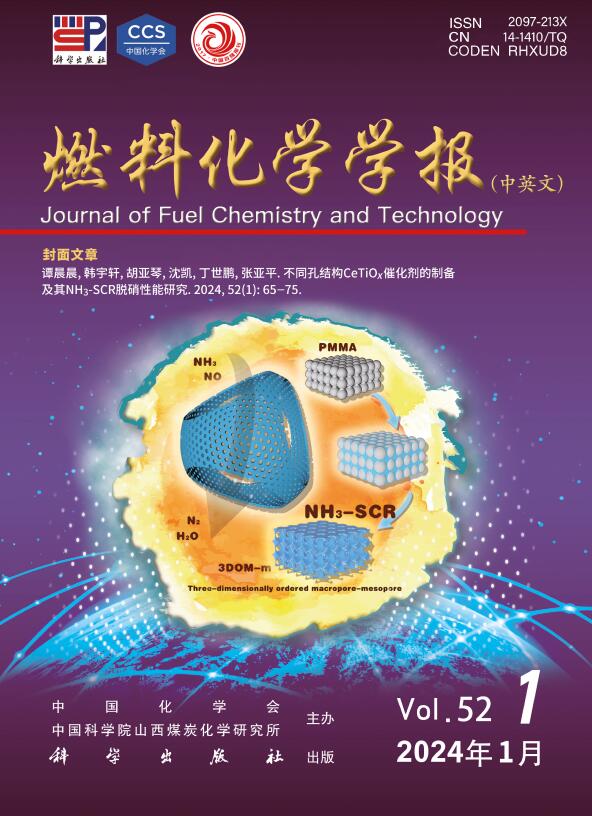Effect of the RhnNin alloy cluster size on the catalytic performance of RhnNin/TiO2 in the conversion of syngas to ethanol
Q3 Energy
引用次数: 0
Abstract
The direct conversion of syngas to ethanol on the RhnNin/TiO2 (n = 1, 2, 3, 4) catalyst has been investigated by using the density functional theory (DFT) and micro-kinetic methods, in order to elucidate the regulatory mechanism of RhnNin alloy cluster size-induced metal-support interaction on the catalytic performance of RhnNin/TiO2 in the ethanol synthesis. The results indicate that Rh1Ni1/TiO2 and Rh3Ni3/TiO2 can significantly enhance the conversion of CO and the formation of C–C bond and meanwhile inhibit the generation of methane. Rh1Ni1/TiO2 exhibits the highest ethanol production activity and relative selectivity. The electronic property analysis results suggest that Ni atoms on the alloy clusters and Ti and O atoms on the supports transfer the most charge to the Rh atoms on the Rh1Ni1/TiO2 catalyst, which displays the strongest Rh-Ni interaction on the alloy clusters as well as the strongest interaction between the alloy clusters and the TiO2 support, endowing Rh1Ni1/TiO2 with the highest catalytic activity. In addition, the Ab-initio molecular dynamics (AIMD) simulations at 525 K show that the Rh1Ni1/TiO2 catalyst has high thermal stability.
RhnNin 合金团簇尺寸对 RhnNin/TiO2 在合成气转化为乙醇过程中催化性能的影响
利用密度泛函理论(DFT)和微观动力学方法研究了RhnNin/TiO2(n = 1, 2, 3, 4)催化剂将合成气直接转化为乙醇的过程,以阐明RhnNin合金团簇尺寸诱导的金属-支撑相互作用对RhnNin/TiO2在乙醇合成过程中催化性能的调控机制。结果表明,Rh1Ni1/TiO2 和 Rh3Ni3/TiO2 能显著提高 CO 的转化率和 C-C 键的形成,同时抑制甲烷的生成。Rh1Ni1/TiO2 的乙醇生产活性和相对选择性最高。电子性质分析结果表明,Rh1Ni1/TiO2 催化剂中合金团簇上的 Ni 原子以及载体上的 Ti 原子和 O 原子将最多的电荷转移给 Rh 原子,合金团簇上的 Rh-Ni 相互作用最强,合金团簇与 TiO2 载体之间的相互作用也最强,从而赋予 Rh1Ni1/TiO2 最高的催化活性。此外,在 525 K 下进行的 Ab-initio 分子动力学(AIMD)模拟表明,Rh1Ni1/TiO2 催化剂具有很高的热稳定性。
本文章由计算机程序翻译,如有差异,请以英文原文为准。
求助全文
约1分钟内获得全文
求助全文
来源期刊

燃料化学学报
Chemical Engineering-Chemical Engineering (all)
CiteScore
2.80
自引率
0.00%
发文量
5825
期刊介绍:
Journal of Fuel Chemistry and Technology (Ranliao Huaxue Xuebao) is a Chinese Academy of Sciences(CAS) journal started in 1956, sponsored by the Chinese Chemical Society and the Institute of Coal Chemistry, Chinese Academy of Sciences(CAS). The journal is published bimonthly by Science Press in China and widely distributed in about 20 countries. Journal of Fuel Chemistry and Technology publishes reports of both basic and applied research in the chemistry and chemical engineering of many energy sources, including that involved in the nature, processing and utilization of coal, petroleum, oil shale, natural gas, biomass and synfuels, as well as related subjects of increasing interest such as C1 chemistry, pollutions control and new catalytic materials. Types of publications include original research articles, short communications, research notes and reviews. Both domestic and international contributors are welcome. Manuscripts written in Chinese or English will be accepted. Additional English titles, abstracts and key words should be included in Chinese manuscripts. All manuscripts are subject to critical review by the editorial committee, which is composed of about 10 foreign and 50 Chinese experts in fuel science. Journal of Fuel Chemistry and Technology has been a source of primary research work in fuel chemistry as a Chinese core scientific periodical.
 求助内容:
求助内容: 应助结果提醒方式:
应助结果提醒方式:


